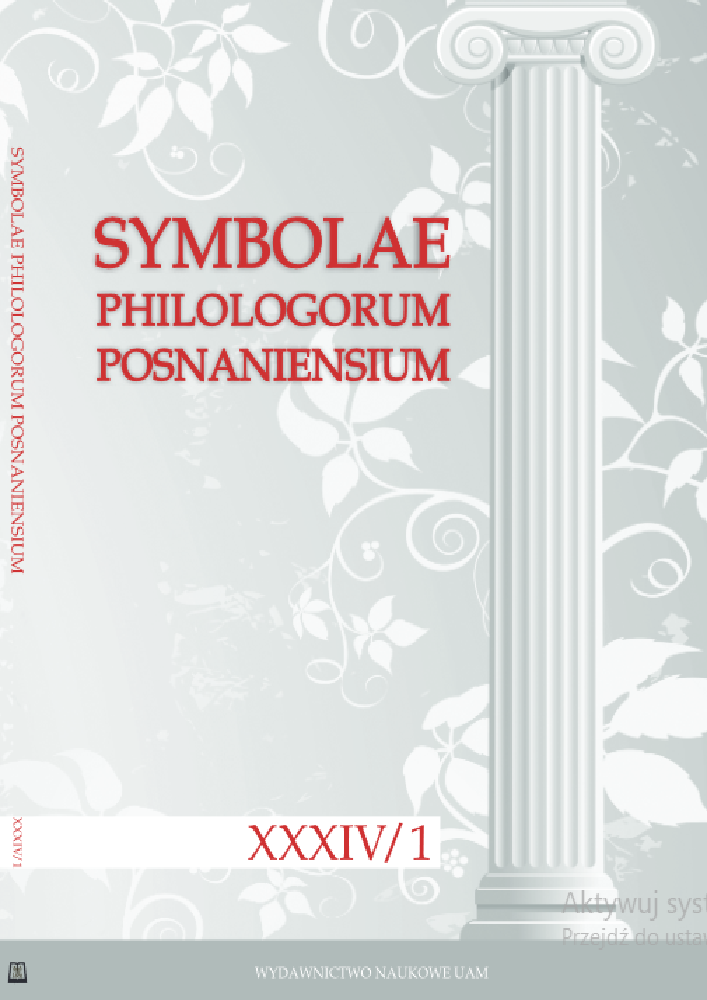Abstract
This article presents one of the most famous Renaissance Latin epyllions dealing with the motif of the Harrowing of Hell – Carmen de Triumpho Christi by Macario Muzio (a. 1440–a. 1523), a nobleman from Camerino. Written at the end of the 15th century, the work gained popularity and was eagerly imitated by other humanists (including Erasmus of Rotterdam and Eobanus Hessus). The epyllion, constructed according to the rules of ancient epic, is an example of the Christianisation of classical genres in the Renaissance. The article presents the life of the author and his views on Christian poetry, as well as a thorough analysis of the work. It provides the Latin text of Carmen, accompanied by similia, and its Polish translation, supplemented by a commentary.
Literaturhinweise
Angelus Politianus, Opera, quae quidem extitere hactenus, omnia, longe emendatius quam usquam antehac expressa… [Nicolaus Episcopius: Basileae 1553].
Heroicum Macarii Mutii de triumpho Christi, cui annexum est Elegiacum magistri Pauli Crosnensis Rutheni ad divam virginem Mariam [Cracoviae 1515].
Macarius Mutius, Macarius Mutius eques Camers. De triumpho Christi [Otinus Papiensis: Venetiis 1502].
Macarius Mutius, Carme[n] de Triu[m]pho Christi gravissimu[m] atq[ue] elegantissimu[m] cum Josephi Horlennii Segenensis exclaratione [Martinus Werdensis: Coloniae 1515].
Macarius Mutius, Triumphus Christi, vel Victoria crucis, w: Dominici Mancini poemata. Hieronymi Vallensis Patavini Iesuidos, vel de Dominica passione Lib. I. Cum aliis sacris aliquot poematiis, quorum auctores proxima indicabit pagella [Ioannes Bellerus: Antverpiae 1559].
Adamczyk 1980: M. Adamczyk, Biblijno-apokryficzne narracje w literaturze staropolskiej do końca XVI wieku, Poznań 1980.
Budzisz 1995: A. Budzisz, Biblia i tradycja antyczna. Motywy analogiczne w łacińskiej poezji biblijnej renesansu (Polska, Niemcy, Niderlandy, Wyspy Brytyjskie), Lublin 1995.
Calvi 1664: D. Calvi, Scena letteraria de gli scrittori Bergamaschi aperta alla curiosità de suoi concittadini, Bergamo 1664.
Campbell 1982: J. Campbell, To Hell and Back. Latin Tradition and Literary Use of the ‘Descensus ad inferos’ in Old English, „Viator” XIII (1982), 107–158. DOI: https://doi.org/10.1484/J.VIATOR.2.301465
Chialà 2012: S. Chialà, Discese agli inferi, Comunità di Bose 2012.
Connell 2001: M. Connell, ‘Descensus Christi ad inferos’. Christ’s Descent to the Dead, „Theological Studies” LXII (2001), 262–282. DOI: https://doi.org/10.1177/004056390106200202
Czapla 2013: R. Czapla, Das Bibelepos in der Frühen Neuzeit. Zur deutschen Geschichte einer europäischen Gattung, Berlin–Boston 2013. DOI: https://doi.org/10.1515/9783110263770
Feliciangeli 1922: B. Feliciangeli, Notizie sulla vita e sulle opere di Macario Muzio da Camerino. Una sua lettera inedita, w: Scritti storici in memoria di Giovanni Monticolo, a cura di C. Cipolla et al., Venezia 1922.
Haas 1981: A. Haas, ‘Descensus ad inferos’. Höllenfahrten und Jenseitsvisionen im Mittelalter vor Dante, „Internationale Katholische Zeitschrift Communio” X (1981), z. 1, 40–56.
Katechizm Kościoła Katolickiego, Poznań 1994.
Kowzan 2008: J. Kowzan, „Zstąpił do piekieł, trzeciego dnia zmartwychwstał”? – glosa do „Historyi o chwalebnym Zmartwychwstaniu Pańskim”, „Pamiętnik Literacki” III (2008), 173–178.
Lewalski 1966: B. Lewalski, Milton’s Brief Epic. The Genre, Meaning, and Art of Paradise Regained, Providence 1966.
Messenger 1936: R. Messenger, The Descent Theme in Medieval Latin Hymns, „Transactions and Proceedings of the American Philological Association” LXVII (1936), 126–147. DOI: https://doi.org/10.2307/283232
Okoń 2004: Mikołaj z Wilkowiecka, Historyja o chwalebnym Zmartwychwstaniu Pańskim, red. J. Okoń, Wrocław–Warszawa 2004.
Peters 2019: Ch. Peters, Narrative structures in Neo-Latin epic from 1440 to 1500, w: Structures of Epic Poetry, vol. III, eds. Ch. Reitz, S. Finkmann, Berlin 2019. DOI: https://doi.org/10.1515/9783110492590-072
Reddemann 2021: L. Reddemann, Epic Salvation. Christ’s Descent into Hell and the Landscape of the Underworld in Neo-Latin Christian Epic, w: Landscape and the Visual Hermeneutics of Place, 1500–1700, eds. K. Enenkel, W. Melion, Leiden 2021. DOI: https://doi.org/10.1163/9789004440401_017
Romanowiczowa 1954: Z. Romanowiczowa, Ewangelia Nikodema i jej staropolskie echa, „Życie: katolicki tygodnik religijno-kulturalny” XIX (1954), 3–4.
Springer 1991: C. Springer, Macarius Mutius’s ‘De Triumpho Christi’. Christian Epic Theory and Practice in the Late Quattrocento, w: Acta Conventus Neo-Latini Torontonensis. Proceedings of the Seventh International Congress of Neo-Latin Studies, Toronto 8 August to 13 August 1988, eds. A. Dalzell, Ch. Fantazzi, R. Schoeck, Binghamton, New York 1991.
Springer 2003: C. Springer, The Biblical Epic in Late Antiquity and the Early Modern Period. The Poetics of Tradition, w: Antiquity Renewed. Late Classical and Early Modern Themes, eds. V.M. Schmidt, Z. von Martels, V.M. Schmidt, Leuven 2003.
Średniowieczna poezya łacińska w Polsce, red. A. Brückner, Kraków 1892.
Turner 1966: R. Turner, ‘Descendit ad inferos’. Medieval Views on Christ’s Descent into Hell and the Salvation of the Ancient Just, „Journal of the History of Ideas” XXVII (1966), z. 2, 173–194. DOI: https://doi.org/10.2307/2708637
Zieziula 2012: B. Zieziula, Zstąpienie Chrystusa do piekieł jako zbawcze wydarzenie w historii zbawienia, „Rocznik Teologii Katolickiej” XI (2012), z. 2, 111–120.


